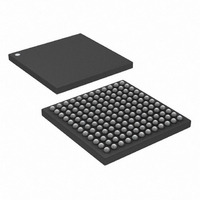DS3141+ Maxim Integrated Products, DS3141+ Datasheet - Page 10

DS3141+
Manufacturer Part Number
DS3141+
Description
IC FRAMER DS3/E3 SNGL 144CSBGA
Manufacturer
Maxim Integrated Products
Datasheet
1.DS3141.pdf
(88 pages)
Specifications of DS3141+
Controller Type
DS3/E3 Framer
Interface
LIU
Voltage - Supply
3.135 V ~ 3.465 V
Current - Supply
80mA
Operating Temperature
-40°C ~ 85°C
Mounting Type
Surface Mount
Package / Case
144-CSBGA
Lead Free Status / RoHS Status
Lead free / RoHS Compliant
5.3 Transmit Formatter System Interface Pins
TOHEN
TGCLK
TDEN/
NAME
TICLK
TSOF
TDAT
TMEI
TOH
TYPE
O/I
O
I
I
I
I
I
Transmit Input Clock. TICLK samples the TDAT, TDEN/TGCLK, TSOF, TOH, and TOHEN input pins.
TICLK accepts a smooth clock or a gapped clock up to 52MHz. When the framer is connected to an LIU
without a jitter attenuator, TICLK should be an ungapped, transmission-quality DS3 or E3 clock (±20ppm,
low jitter) to meet the frequency accuracy and jitter requirements for transmission. The default active
sampling edge of TICLK is the rising edge. To make the negative edge the active sampling edge, set
MC3:TICLKI = 1.
Transmit Data Input. In C-Bit Parity DS3 mode, payload bits are clocked into the transmit formatter on
TDAT. In M23 DS3 mode and E3 mode, payload bits, stuff opportunity bits and C bits are clocked in on
TDAT. TDAT is sampled on the active sampling edge of TICLK. The default active sampling edge of
TICLK is the rising edge. To make the negative edge the active sampling edge, set MC3:TICLKI = 1.
TDAT can be internally inverted by setting MC3:TDATI = 1.
Transmit Data Enable/Transmit Gapped Clock. The transmit formatter can be configured to either output a
data enable (TDEN) or a gapped clock (TGCLK). In data enable mode, TDEN goes active when payload
data should be made available on the TDAT input pin and inactive when the formatter is inserting framing
overhead. In gapped clock mode, TGCLK acts as a demand clock for the TDAT input, toggling for each
payload bit position and not toggling when the formatter is inserting framing overhead. In DS3 mode,
overhead data is defined as the M bits, F bits, C bits, X bits, and P bits. In E3 mode, overhead data is
defined as the FAS word, RAI bit, and Sn bit (bits 1 to 12). To configure the transmit formatter for data
enable mode, set MC3:TDENMS = 0. To configure for gapped clock operation, set MC3:TDENMS = 1.
TDEN is normally active high; to make TDEN active low, set MC3:TDENI = 1. TGCLK normally is the
same polarity as TICLK; to invert TGCLK, set MC3:TDENI = 1. In the transmit pass-through mode
(T3E3CR1:TPT = 1), TDEN/TGCLK continues to mark the payload positions in the original frame
established before TPT was activated. This pin can also be made to output a constant transmit clock by
setting MC2:TCCLK = 1. This constant clock is useful for certain applications that need to use the TOH
and TOHEN pins during payload loopback.
Transmit Start-of-Frame. TSOF indicates the DS3 or E3 frame boundary on the outgoing transmit data
stream. When TSOFC = 1 in the
during the last bit of each DS3 or E3 frame. When TSOFC = 0, TSOF is an input and is sampled to set the
transmit DS3 or E3 frame boundary. See
TSOF to be an input. Some applications require an external pullup or pulldown resistor on TSOF to keep it
from floating during power-up and reset. TSOF is normally active high. Set MC3:TSOFI = 1 to make TSOF
active low. If transmit pass-through (TPT) mode is enabled (T3E3CR1:TPT = 1) and TSOF is an output,
TSOF continues to mark the original frame position that was established before TPT activation.
Transmit Overhead Enable. Together the TOHEN and TOH pins make a simple, general-purpose
transmit-overwrite port. This port is usually used to overwrite overhead bit positions (such as unused C
bits in C-Bit Parity mode), but payload bits can be overwritten as well. During any clock cycle in which
TOHEN is active, the formatter sources the TOH pin rather than the TDAT pin or the internal overhead
generation logic. In DS3 mode, parity is not recalculated if any payload bits are overwritten. TOHEN can
be internally inverted by setting MC3:TOHENI = 1.
Transmit Overhead Data. Together the TOHEN and TOH pins make a simple, general-purpose transmit-
overwrite port. This port is usually used to overwrite overhead bit positions (such as unused C bits in C-Bit
Parity mode), but payload bits can be overwritten as well. During any clock cycle in which TOHEN is
active, the formatter sources the TOH pin rather than the TDAT pin or the internal overhead generation
logic. TOH can be inverted by setting MC3:TOHI = 1.
Transmit Manual-Error Insert. This pin is used to manually control the insertion of errors in the DS3 or E3
frame structure or the line coding. This pin is enabled when MEIMS = 1 in the
error is normally inserted on the rising edge of TMEI. The other bits in the
types of errors are inserted. All framers on the device share this pin.
MC3
10 of 88
register, TSOF is an output and pulses high for one TICLK cycle
Figure 5-1
FUNCTION
for functional timing. Note that the reset default is for
T3E3EIC
T3E3EIC
register control which
register. A single











